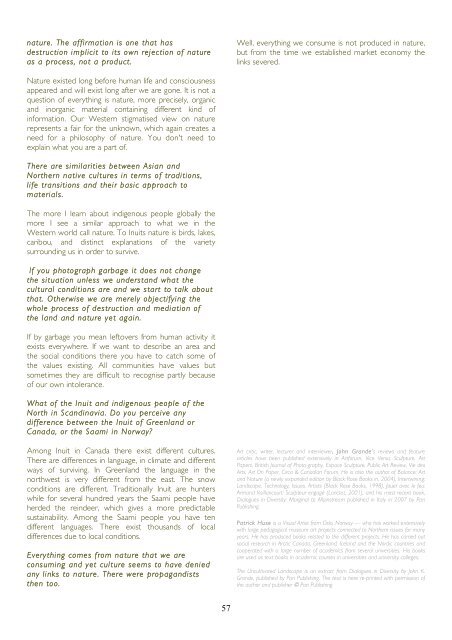M - Antennae The Journal of Nature in Visual Culture
M - Antennae The Journal of Nature in Visual Culture
M - Antennae The Journal of Nature in Visual Culture
Create successful ePaper yourself
Turn your PDF publications into a flip-book with our unique Google optimized e-Paper software.
nature. <strong>The</strong> affirmation is one that has<br />
destruction implicit to its own rejection <strong>of</strong> nature<br />
as a process, not a product.<br />
<strong>Nature</strong> existed long before human life and consciousness<br />
appeared and will exist long after we are gone. It is not a<br />
question <strong>of</strong> everyth<strong>in</strong>g is nature, more precisely, organic<br />
and <strong>in</strong>organic material conta<strong>in</strong><strong>in</strong>g different k<strong>in</strong>d <strong>of</strong><br />
<strong>in</strong>formation. Our Western stigmatised view on nature<br />
represents a fair for the unknown, which aga<strong>in</strong> creates a<br />
need for a philosophy <strong>of</strong> nature. You don't need to<br />
expla<strong>in</strong> what you are a part <strong>of</strong>.<br />
<strong>The</strong>re are similarities between Asian and<br />
Northern native cultures <strong>in</strong> terms <strong>of</strong> traditions,<br />
life transitions and their basic approach to<br />
materials.<br />
<strong>The</strong> more I learn about <strong>in</strong>digenous people globally the<br />
more I see a similar approach to what we <strong>in</strong> the<br />
Western world call nature. To Inuits nature is birds, lakes,<br />
caribou, and dist<strong>in</strong>ct explanations <strong>of</strong> the variety<br />
surround<strong>in</strong>g us <strong>in</strong> order to survive.<br />
If you photograph garbage it does not change<br />
the situation unless we understand what the<br />
cultural conditions are and we start to talk about<br />
that. Otherwise we are merely objectify<strong>in</strong>g the<br />
whole process <strong>of</strong> destruction and mediation <strong>of</strong><br />
the land and nature yet aga<strong>in</strong>.<br />
If by garbage you mean leftovers from human activity it<br />
exists everywhere. If we want to describe an area and<br />
the social conditions there you have to catch some <strong>of</strong><br />
the values exist<strong>in</strong>g. All communities have values but<br />
sometimes they are difficult to recognise partly because<br />
<strong>of</strong> our own <strong>in</strong>tolerance.<br />
What <strong>of</strong> the Inuit and <strong>in</strong>digenous people <strong>of</strong> the<br />
North <strong>in</strong> Scand<strong>in</strong>avia. Do you perceive any<br />
difference between the Inuit <strong>of</strong> Greenland or<br />
Canada, or the Saami <strong>in</strong> Norway?<br />
Among Inuit <strong>in</strong> Canada there exist different cultures.<br />
<strong>The</strong>re are differences <strong>in</strong> language, <strong>in</strong> climate and different<br />
ways <strong>of</strong> surviv<strong>in</strong>g. In Greenland the language <strong>in</strong> the<br />
northwest is very different from the east. <strong>The</strong> snow<br />
conditions are different. Traditionally Inuit are hunters<br />
while for several hundred years the Saami people have<br />
herded the re<strong>in</strong>deer, which gives a more predictable<br />
susta<strong>in</strong>ability. Among the Saami people you have ten<br />
different languages. <strong>The</strong>re exist thousands <strong>of</strong> local<br />
differences due to local conditions.<br />
Everyth<strong>in</strong>g comes from nature that we are<br />
consum<strong>in</strong>g and yet culture seems to have denied<br />
any l<strong>in</strong>ks to nature. <strong>The</strong>re were propagandists<br />
then too.<br />
57<br />
Well, everyth<strong>in</strong>g we consume is not produced <strong>in</strong> nature,<br />
but from the time we established market economy the<br />
l<strong>in</strong>ks severed.<br />
Art critic, writer, lecturer and <strong>in</strong>terviewer, John Grande's reviews and feature<br />
articles have been published extensively <strong>in</strong> Artforum, Vice Versa, Sculpture, Art<br />
Papers, British <strong>Journal</strong> <strong>of</strong> Photo-graphy, Espace Sculpture, Public Art Review, Vie des<br />
Arts, Art On Paper, Circa & Canadian Forum. He is also the author <strong>of</strong> Balance: Art<br />
and <strong>Nature</strong> (a newly expanded edition by Black Rose Books <strong>in</strong>, 2004), Intertw<strong>in</strong><strong>in</strong>g:<br />
Landscape, Technology, Issues, Artists (Black Rose Books, 1998), Jouer avec le feu:<br />
Armand Vaillancourt: Sculpteur engagé (Lanctot, 2001), and his most recent book,<br />
Dialogues <strong>in</strong> Diversity: Marg<strong>in</strong>al to Ma<strong>in</strong>stream published <strong>in</strong> Italy <strong>in</strong> 2007 by Pari<br />
Publish<strong>in</strong>g.<br />
Patrick Huse is a <strong>Visual</strong> Artist from Oslo, Norway — who has worked extensively<br />
with large pedagogical museum art projects connected to Northern issues for many<br />
years. He has produced books related to the different projects. He has carried out<br />
social research <strong>in</strong> Arctic Canada, Greenland, Iceland and the Nordic countries and<br />
cooperated with a large number <strong>of</strong> academics from several universities. His books<br />
are used as text books <strong>in</strong> academic courses <strong>in</strong> universities and university colleges.<br />
<strong>The</strong> Uncultivated Landscape is an extract from Dialogues <strong>in</strong> Diversity by John K.<br />
Grande, published by Pari Publish<strong>in</strong>g. <strong>The</strong> text is here re-pr<strong>in</strong>ted with permission <strong>of</strong><br />
the author and publisher � Pari Publish<strong>in</strong>g












